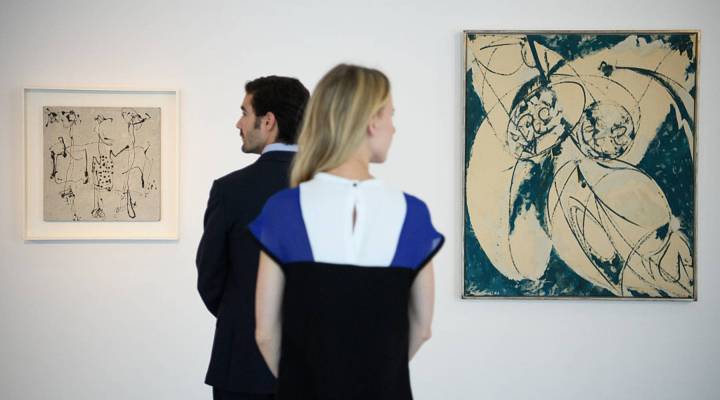
It’s a good time to buy art made by women

We’re headed into the fall art auction season, which means international art fairs, exhibitions and high-profile sales are about to begin. Historian and biographer Mary Gabriel has a tip: Buy art made by women. She explains why in the pages of the New York Times and explores it thematically in her new book, “Ninth Street Women,” about a group of five influential and newly relevant modern artists, which comes out Sept. 25. She discussed the book with Marketplace host Kai Ryssdal. The following is an edited transcript of their conversation.

Kai Ryssdal: One hates to be too naked about this up front, but the basic gist of this article you’ve written in the paper and also the book is that not only is women’s art undervalued, but now’s a really good time to buy women’s art because it is undervalued.
Mary Gabriel: It is. It’s funny, you know, the point of the book is about the sort of spirituality of art and this wonderful scene, this pure scene before art became a business. But what we inherited from this group, from the abstract expressionists in the 1950s, is the art market. Because basically, it was born in the mid-1950s, the American art market, for a number of reasons: tax reasons, tax breaks were given to collectors and the economy was booming and people didn’t know what to do with their money. And so women are part of that, though historically they’ve been neglected.
Ryssdal: Can I ask a really non-art connoisseur question? It goes like this: Is the art that women do different than the art that men do?
Gabriel: No. It’s Amazing. Lee Krasner, one of the women I write about, said that this discrimination or this bias against women artists is as old as Judeo-Christianity, and, in fact, it is, because it’s born in the very notion of God, who is a “He,” you know, the initial creator. And so that’s quite a burden for a woman artist. But the women abstract expressionists really broke through that gender barrier and became very famous in their own time. When the art world became an art business, dealers stopped showing women because collectors — once again, because this was the tradition in the history of art — collectors didn’t think women’s work had as much value. And so that’s when you begin to see women really being discriminated against.

Lee Krasner in Jackson Pollock’s studio in 1949.
Ryssdal: What about, though, sort of contemporary-ish artists working today who want, like, gallery space, right? Are women getting that, or are they getting the exposure?
Gabriel: They are, and it’s really heartening to see finally, because this has been a fight that’s been going on for decades. What’s happened is that galleries for a number of reasons — one because of the kind of renewed interest in women’s rights in general in society, another because there’s been activist feminist artists who’ve been really working for many, many years to try to draw attention to women artists. And thirdly, once again, the economics of it. Dealers are awakening to the idea that women artists are of value and of interest to collectors, and so now, 30 percent of the gallery’s stable might be women artists. Now, to put that in perspective, in the United States, 51 percent of the professional artists are women. So they’re not represented in galleries at the rate they are in existence, but we’re getting there.
Ryssdal: So give me your guess for the upcoming, I guess it’s a fall auction season, right? Are we going to see women artists getting the dollar amounts that maybe they haven’t in the past?

Joan Mitchell, City Landscape, 1955.
Gabriel: Oh, I think definitely. You know, whether it’s the dollar amount they deserve just yet, I don’t know, but I think definitely they’ll be getting the attention. Because it’s really a fantastic time to be a collector and to be able to discover these women who, you know, might have painted 70 years ago, but their work is completely new because it’s been so neglected. And so you take an artist like Joan Mitchell, who is really one of the strongest painters to emerge out of the abstract expressionist period. But she was also very timid and she didn’t want to become part of the art market and the whole hustle of trying to sell. And so she moved to France and worked on her own in a property where Claude Monet had once lived and painted beautiful masterpieces. And now collectors are discovering her and she’s actually broken a record. Last spring at auction, there were 15 women who broke sales records because collectors are discovering that there is an entire market of incredibly talented people.

Elaine de Kooning, Juarez, 1958.
There’s a lot happening in the world. Through it all, Marketplace is here for you.
You rely on Marketplace to break down the world’s events and tell you how it affects you in a fact-based, approachable way. We rely on your financial support to keep making that possible.
Your donation today powers the independent journalism that you rely on. For just $5/month, you can help sustain Marketplace so we can keep reporting on the things that matter to you.












